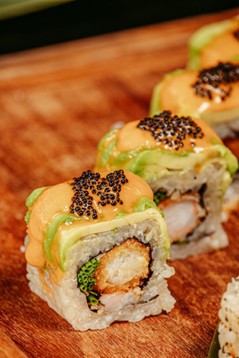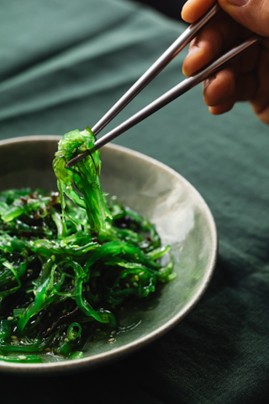
When people think of global cuisine, they often picture spices, grains, or proteins: Japanese sushi, Korean BBQ, Nordic smoked fish. But beneath the surface, literally, there’s a secret ingredient that binds these culinary traditions together: sushi seaweed sheets.
From the Pacific coastlines of Japan and Korea to the chilly, rugged shores of Scandinavia, ocean-harvested greens such as seaweed, kelp, dulse, laver, and more, have long been treasured not only for their deep umami flavors but also for their health benefits and sustainability. This article takes you on a journey through three distinct cultures to explore how this humble sea vegetable has shaped cuisines, supported communities, and is now being rediscovered on global plates.
In Japan, seaweed isn’t just an ingredient, it’s a cultural cornerstone. Known locally as nori, kombu, and wakame, different types are used in nearly every part of Japanese cuisine.
Kombu is a type of kelp. It forms the foundation of dashi, the umami-rich broth that flavors miso soup, noodle dishes, and simmered stews. Steeped gently, kombu releases glutamic acid - a natural source of umami, the fifth taste - which gives Japanese cuisine its signature depth and warmth.
Most people know nori as the green, paper-thin wraps on sushi rolls. But it’s also toasted, crumbled over rice, used in snacks, and even brewed into tea. Nori is rich in iodine, B vitamins, and trace minerals. Its savory, slightly nutty profile makes it a favorite across all ages.
Wakame is a tender, dark green aquatic flora found in miso soup and salads. It has a mild, slightly sweet flavor and a silky texture. Wakame is a powerhouse of calcium and magnesium, and studies suggest it may help regulate blood pressure and metabolism, contributing to Japan’s high longevity rates.
For the Japanese, food is about balance, simplicity, and wellness. It’s a daily habit that links diet to harmony with the sea, health, and the seasons.
While Japanese cuisine highlights seaweed’s delicacy, Korean cuisine celebrates its boldness. Ocean greens (miyeok, gim, and dashima) play both culinary and symbolic roles in Korean life.
Miyeokguk, a warm soup, is traditionally eaten on birthdays and after childbirth. Made with beef broth or anchovy stock and miyeok (a type of brown seaweed), it’s nourishing, high in iron and calcium, and believed to aid postpartum recovery. This tradition dates back centuries, rooted in Korea’s deep respect for ancestry and renewal.
Gim is Korea’s answer to nori, but with a twist: often brushed with sesame oil and salt, it’s grilled or roasted for a crisp, savory snack. It’s served with rice, wrapped around fillings, or simply enjoyed as a side dish. Gim production has become a significant industry, especially in the southern coastal regions, supporting local economies and cultural exports.
Dashima (Korean kelp) is frequently used to create broth bases for stews, soups, and kimchi brines. When fermented or aged, its flavors deepen, much like kombu, and become a critical layer of flavor in dishes like doenjang jjigae (soybean stew).
For Koreans, the aquatic flora represents strength, nourishment, and history - a food that connects generations and elevates the flavors of traditional cooking.

Travel far north to the Nordic countries - Norway, Iceland, Denmark - and you’ll find that ocean greens, while less famous in mainstream cuisine, is undergoing a revival. Historically used during famines and food shortages, it is now celebrated for its sustainability and superfood status.
Dulse, a reddish-purple seaweed found along the North Atlantic coasts, was once dried and eaten by Viking sailors for sustenance. Today, it’s harvested by hand, sun-dried, and used in soups, breads, and butter blends. When pan-fried, it famously tastes like bacon, a surprise that has made it a trendy ingredient in plant-based cooking.
Modern chefs and foragers are embracing local species like knotted wrack and sugar kelp, incorporating them into butter sauces, breads, and seafood dishes. They are high in antioxidants and iodine, and grow abundantly in cold, clean waters.
Seaweed’s return aligns perfectly with the principles of New Nordic cuisine: local, seasonal, sustainable. Fine dining restaurants in Copenhagen and Reykjavik are now infusing ocean greens into marinades, pickles, and even desserts, reintroducing it as a versatile and elegant ingredient.
The widespread use of these products in these diverse cuisines is no coincidence. Across cultures and centuries, ocean-harvested greens have been recognized for their:
Seaweed is one of the most eco-friendly crops on the planet. It requires no freshwater, no fertilizer, and no arable land. In fact, seaweed farming absorbs carbon dioxide, cleans water, and creates marine habitat.
In each of these regions, seaweed connects people to land, heritage, and wellness. Whether as a symbol of new life in Korea, a source of longevity in Japan, or a foraged ingredient in modern Nordic cuisine, it reminds us of food’s deeper role in shaping identity.
With rising awareness of climate change, nutrition, and global food systems, seaweed is stepping into the spotlight. It's increasingly found in:
Chefs and consumers around the world are recognizing that what once seemed exotic or humble is in fact one of the planet’s most powerful foods - ancient, adaptable, and essential.
Though separated by thousands of miles and cultural differences, Japan, Korea, and Nordic countries share a bond forged in the waves: the ability to see value, beauty, and nourishment in the sea.
Seaweed is more than just an ingredient - it’s a story of resilience, resourcefulness, and renewal. Folded into sushi, simmered into soup, or foraged from icy coastlines, ocean-harvested greens are the secret ingredient that feeds both body and spirit.
As we look toward a more sustainable and health-conscious future, perhaps it’s time we all returned to the sea - not just for inspiration, but for nourishment, too.